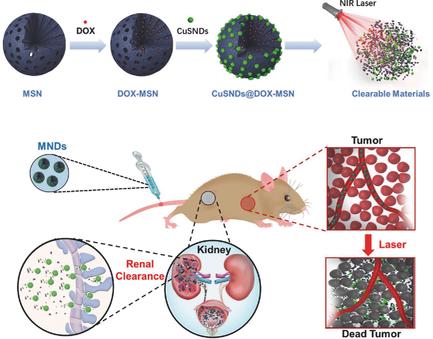当前位置:
X-MOL 学术
›
Adv. Funct. Mater.
›
论文详情
Our official English website, www.x-mol.net, welcomes your
feedback! (Note: you will need to create a separate account there.)
High‐Efficient Clearable Nanoparticles for Multi‐Modal Imaging and Image‐Guided Cancer Therapy
Advanced Functional Materials ( IF 18.5 ) Pub Date : 2017-11-10 , DOI: 10.1002/adfm.201704634 Qiaolin Wei 1, 2 , Yao Chen 1 , Xibo Ma 3 , Jianfeng Ji 1 , Yue Qiao 1, 2 , Bo Zhou 1, 2 , Fei Ma 2 , Daishun Ling 4 , Hong Zhang 1 , Mei Tian 1 , Jie Tian 3 , Min Zhou 1, 2, 5, 6
Advanced Functional Materials ( IF 18.5 ) Pub Date : 2017-11-10 , DOI: 10.1002/adfm.201704634 Qiaolin Wei 1, 2 , Yao Chen 1 , Xibo Ma 3 , Jianfeng Ji 1 , Yue Qiao 1, 2 , Bo Zhou 1, 2 , Fei Ma 2 , Daishun Ling 4 , Hong Zhang 1 , Mei Tian 1 , Jie Tian 3 , Min Zhou 1, 2, 5, 6
Affiliation

|
Renal‐clearable nanoparticles have made it possible to overcome the toxicity by nonspecific accumulation in healthy tissues/organs due to their highly efficient clearance characteristics. However, their tumor uptake is relatively low due to the short blood circulation time and rapid body elimination. Here, this problem is addressed by developing renal‐clearable nanoparticles by controlled coating of sub‐6 nm CuS nanodots (CuSNDs) on doxorubicin ladened mesoporous silica nanoparticles (pore size ≈6 nm) for multimodal application. High tumor uptake of the as‐synthesized nanoparticles (abbreviated as MDNs) is achieved due to the longer blood circulation time. The MDNs also show excellent performance in bimodal imaging. Moreover, the MDNs demonstrated a photothermally sensitive drug release and pronounced synergetic effects of chemo‐photothermal therapy, which were confirmed by two different tumor models in vivo. A novel key feature of the proposed synthesis is the use of renal‐clearable CuSNDs and biodegradable mesoporous silica nanoparticles which also are renal‐clearable after degradation. Therefore, the MDNs would be rapidly degraded and excreted in a reasonable period in living body and avoid long‐term toxicity. Such biodegradable and clearable single‐compartment theranostic agents applicable in highly integrated multimodal imaging and multiple therapeutic functions may have substantial potentials in clinical practice.
中文翻译:

高效可清除纳米颗粒,用于多模式成像和图像指导的癌症治疗
可通过肾脏清除的纳米颗粒由于具有高效清除特性,因此可以通过在健康组织/器官中非特异性积累来克服毒性。然而,由于短的血液循环时间和快速的身体清除,它们的肿瘤摄取相对较低。在这里,通过在阿霉素包被的中孔二氧化硅纳米颗粒(孔径约6 nm)上进行亚6 nm的CuS纳米点(CuSND)的可控涂层来开发肾脏可清除的纳米颗粒,以解决多模态应用,从而解决了这个问题。由于更长的血液循环时间,可以实现合成纳米颗粒(缩写为MDNs)的高肿瘤吸收。MDN在双峰成像中也显示出出色的性能。而且,MDNs显示了光热敏感的药物释放和化学光热疗法的显着协同作用,这在体内有两种不同的肿瘤模型得到了证实。拟议的合成方法的新关键特征是使用可肾脏清除的CuSND和可生物降解的介孔二氧化硅纳米粒子,它们在降解后也可通过肾脏清除。因此,MDNs将在生物体内合理的时间内迅速降解并排泄,避免长期毒性。适用于高度集成的多模式成像和多种治疗功能的这种可生物降解和清除的单室治疗药物可能在临床实践中具有巨大潜力。拟议的合成方法的新关键特征是使用可肾脏清除的CuSND和可生物降解的介孔二氧化硅纳米粒子,它们在降解后也可通过肾脏清除。因此,MDNs将在生物体内合理的时间内迅速降解并排泄,避免长期毒性。适用于高度集成的多模式成像和多种治疗功能的这种可生物降解和清除的单室治疗药物可能在临床实践中具有巨大潜力。拟议的合成方法的新关键特征是使用可肾脏清除的CuSND和可生物降解的介孔二氧化硅纳米粒子,它们在降解后也可通过肾脏清除。因此,MDNs将在生物体内合理的时间内迅速降解并排泄,避免长期毒性。适用于高度集成的多模式成像和多种治疗功能的这种可生物降解和清除的单室治疗药物可能在临床实践中具有巨大潜力。
更新日期:2017-11-10
中文翻译:

高效可清除纳米颗粒,用于多模式成像和图像指导的癌症治疗
可通过肾脏清除的纳米颗粒由于具有高效清除特性,因此可以通过在健康组织/器官中非特异性积累来克服毒性。然而,由于短的血液循环时间和快速的身体清除,它们的肿瘤摄取相对较低。在这里,通过在阿霉素包被的中孔二氧化硅纳米颗粒(孔径约6 nm)上进行亚6 nm的CuS纳米点(CuSND)的可控涂层来开发肾脏可清除的纳米颗粒,以解决多模态应用,从而解决了这个问题。由于更长的血液循环时间,可以实现合成纳米颗粒(缩写为MDNs)的高肿瘤吸收。MDN在双峰成像中也显示出出色的性能。而且,MDNs显示了光热敏感的药物释放和化学光热疗法的显着协同作用,这在体内有两种不同的肿瘤模型得到了证实。拟议的合成方法的新关键特征是使用可肾脏清除的CuSND和可生物降解的介孔二氧化硅纳米粒子,它们在降解后也可通过肾脏清除。因此,MDNs将在生物体内合理的时间内迅速降解并排泄,避免长期毒性。适用于高度集成的多模式成像和多种治疗功能的这种可生物降解和清除的单室治疗药物可能在临床实践中具有巨大潜力。拟议的合成方法的新关键特征是使用可肾脏清除的CuSND和可生物降解的介孔二氧化硅纳米粒子,它们在降解后也可通过肾脏清除。因此,MDNs将在生物体内合理的时间内迅速降解并排泄,避免长期毒性。适用于高度集成的多模式成像和多种治疗功能的这种可生物降解和清除的单室治疗药物可能在临床实践中具有巨大潜力。拟议的合成方法的新关键特征是使用可肾脏清除的CuSND和可生物降解的介孔二氧化硅纳米粒子,它们在降解后也可通过肾脏清除。因此,MDNs将在生物体内合理的时间内迅速降解并排泄,避免长期毒性。适用于高度集成的多模式成像和多种治疗功能的这种可生物降解和清除的单室治疗药物可能在临床实践中具有巨大潜力。











































 京公网安备 11010802027423号
京公网安备 11010802027423号